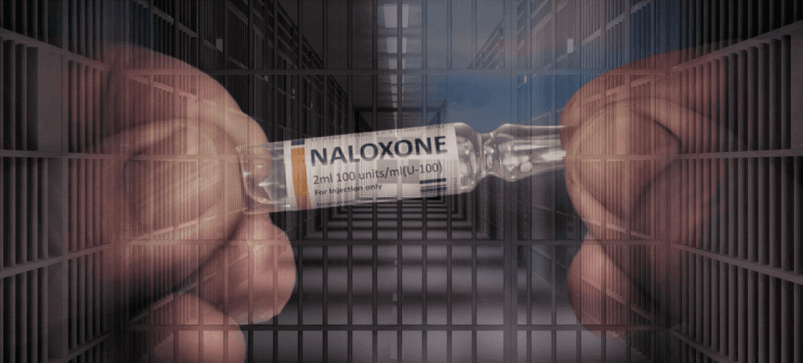Naloxone vending machines make life-saving medication easily available in Michigan jails and communities
County jails and community organizations across Michigan are teaming up on a new approach to distribute naloxone (Narcan®), the life-saving medication used to reverse an opioid overdose, through the use of customized vending machines.
In Michigan and across the country, overdose rates increased in 2020 and were primarily driven by illicitly manufactured fentanyl, an extremely potent synthetic opioid. Research from the Center for Behavioral Health and Justice (CBHJ) at the Wayne State University School of Social Work suggests that more than one out of five overdose deaths in the community are people recently released from jail and other studies suggesting people with criminal/legal system involvement are up to 120 times more likely to have a fatal overdose in the two weeks following release from jail or prison. Fortunately, there is an antidote for opioid overdose that is highly effective – naloxone (commonly known by the brand name Narcan®). Naloxone is a safe and easy to use medication that is approved by the Food and Drug Administration (FDA). It works by knocking opioids (including fentanyl) off the receptors in the brain and blocking them from re-attaching, thereby reversing their effects. Since 2016, there has been a standing order in Michigan that makes naloxone available to the general public without needing a prescription. However, it can be costly to purchase the medication from a local pharmacy and community organizations that distribute it for free often require individuals to complete lengthy trainings or jump through other hoops to obtain a kit.
While the CBHJ was working with county jails across Michigan to expand treatment services for people with opioid use disorder, researchers recognized an opportunity to increase naloxone distribution to this population. In developing the Expanding Naloxone Distribution in County Jails Toolkit, the CBHJ consulted with the Los Angeles County Jail, who has distributed more than 34,000 naloxone kits through use of a vending machine. This approach provided an easy and highly efficient and stigma free way to distribute naloxone to those who need it most. There are similar initiatives taking place in Indiana, Nevada, Ohio, and Rhode Island.
The CBHJ partnered with Shaffer Distributing based in Livonia, Michigan to purchase fifteen vending machines and customize the coils to hold up to 150 naloxone kits. The machines were purchased with grant funds from the Center for Disease Control’s Overdose Data to Action initiative that the CBHJ received through the Michigan Department of Health and Human Services (MDHHS). County jails and community organizations in Michigan can order a bulk supply of free naloxone kits from MDHHS and individuals can request a kit be mailed directly to them through Next Distro.
Coordinators for the CBHJ were met with equal parts interest and hesitation when introducing naloxone vending machines to research partners across the state. Jails and community organizations were excited about the prospect of being some of the first in Michigan to implement this innovative approach. Yet, there was a commonly held misconception that naloxone distribution could encourage people to use opioids. Contrary to this belief, naloxone distribution does not encourage people to use opioids. Research indicates that the number one reason people leaving jail want naloxone is because they have witnessed an overdose in the past and often return to communities where they may need to save the life of a family member, friend, or neighbor who uses opioids. Further, preventing fatal overdose means an individual gets to live another day – a day that they may very well choose to seek safer alternatives for their opioid use, including treatment, something they wouldn’t be able to do if the overdose is fatal.
Through ongoing conversations to dispel myths about naloxone and sharing information about the importance of distributing this life-saving medication, the CBHJ expects to have all fifteen naloxone vending machines placed by October 2021. Sites include county jails in Delta, Jackson, Kalamazoo, Monroe, Oakland, and Wexford counties and community organizations in several cities across the state including Alpena (Alano Club), Baldwin (Harm Reduction Michigan), Detroit (Quality Behavioral Health and Abundant Recovery Services), Grand Rapids (Red Project), Port Huron (Odyssey House), and Walled Lake (Therapeutics).
The CBHJ worked with sites to identify a “stocker” to refill each machine and provide the machine with unique QR code stickers that link to the OpiRescue website/app with information on how to use naloxone, where to get more, and local treatment options. Feedback from the sites who have already received their machines has been overwhelmingly positive. In July 2021, the Monroe and Jackson County Jails were the first to implement these machines in their jail lobbies and distributed 329 naloxone kits in their first month.
County jails who are interested in implementing a vending machine to distribute naloxone at their facility can contact or email the CBHJ to obtain information about purchasing a machine directly from the distributor or to seek grant funds that could help cover the cost of a machine. The CBHJ has also published a toolkit that jails can reference when implementing or expanding a naloxone distribution program.

About the Center for Behavioral Health and Justice: The Wayne State University School of Social Work Center for Behavioral Health and envisions communities in which research, data, and best practices are used by multiple stakeholders to enhance the optimal well-being of individuals with mental illness and/or substance use disorders who come into contact with the criminal/legal system. Learn more
About Overdose Data to Action: Overdose Data to Action (OD2A) supports jurisdictions in collecting high quality, comprehensive, and timely data on nonfatal and fatal overdoses and in using those data to inform prevention and response efforts. OD2A focuses on understanding and tracking the complex and changing nature of the drug overdose epidemic and highlights the need for seamless integration of data into prevention strategies. Learn more